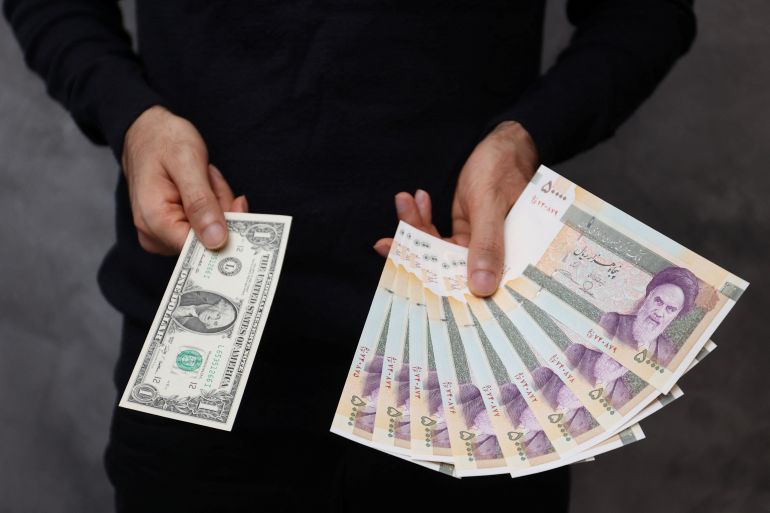Iran’s currency hits all-time low as EU prepares more sanctions
Iranian rial crosses 500,000 to the US dollar as prices of food and essentials continue to rise.

Tehran, Iran – Iran’s national currency has hit an all-time low as the European Union prepares to impose new sanctions on the country in the midst of ongoing tensions with the West.
The United States dollar surpassed a rate of 500,000 rials in the open market on Monday, breaking an important psychological barrier that could signal further depreciation of the embattled national currency in the foreseeable future.
Keep reading
list of 3 itemsIran, West clash over UN watchdog report on Fordow nuclear plant
Iran denies enriching uranium to 84 percent purity amid IAEA row
To put that number into context, one US dollar changed hands for less than 40,000 rials less than five years ago, when the US unilaterally abandoned Iran’s 2015 nuclear deal with world powers and imposed punishing sanctions. The rate was less than 300,000 at the start of last September.
Monday’s currency free fall came as Josep Borrell, the EU’s foreign policy chief, and other bloc officials announced the imminent imposition of another round of sanctions.
Like previous rounds, the measures are expected to target Iranian officials and entities for their response to deadly protests that swept Iran from mid-September. Tehran accuses the West of being behind the unrest.
The EU, along with the US, has in recent months levelled several rounds of sanctions on Tehran for allegedly supplying drones to Russia for its war on Ukraine. Iran and the EU have also clashed over the possibility of designating the Islamic Revolutionary Guard Corps a “terrorist” organisation.
Talks to restore the 2015 nuclear deal also remain deadlocked, with Western parties repeatedly calling on Iran to increase its cooperation with the International Atomic Energy Agency.
Bloomberg reported on Sunday that the global nuclear watchdog has found uranium enriched to 84 percent in Iran, its highest-ever rate. Tehran said finding “particles” does not mean that Iran is enriching beyond the 60 percent it declared before while maintaining that it does not seek a nuclear weapon.
Gov’t response amid inflation
In response to the fast-depreciating national currency, central bank Governor Mohammad Reza Farzin announced on Monday that a new centre to exchange currencies and gold will be launched soon to “discover currency and gold rates based on the economic realities of the country”.
Farzin’s predecessor, Ali Salehabadi, had been sacked in late December after the rial slumped to more than 440,000 against the US dollar on the open market.
Authorities have repeatedly said the establishment’s enemies are trying to derail the Iranian economy through, among other things, fabricating artificially high currency rates.
The central bank has promised to continue enforcing an artificially low rate of 285,000 per dollar for imports of essential goods like medicine to keep prices stable.
But runaway inflation continues to pressure average Iranians who are increasingly losing their purchasing power.
Prices of food and other items continue to surge as the country is nearing the end of its calendar year and Nowruz – Persian New Year – celebrations in late March, when prices traditionally see hikes amid increased demand.
Essential items like meat and onions have repeatedly been in the local news for the past few weeks as they have hit new price highs. Government officials have promised to distribute essential food items with lower prices at select stores as they pledge to control year-end prices.